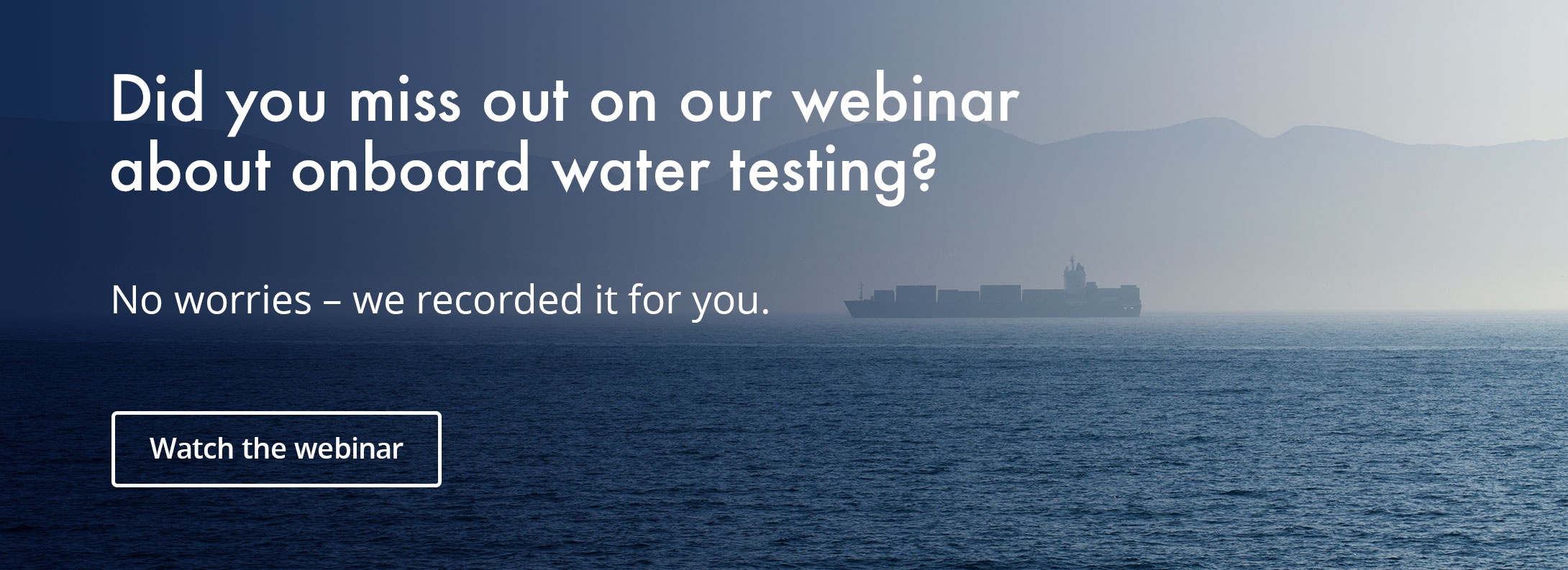Your onboard water can be just as crucial to your vessel as the water surrounding it.
Life on board a ship is in many ways analogous to life on land. Just look at how cruise ships always have strived to offer the comforts we take for granted, but in a marine environment. Merchant vessels do the same to a certain extent, and much of the infrastructure on any marine vessel is the same as what you find in a land-based community. After all, our basic needs remain the same whether on land or at sea. Safe water is no exception.
Discharged water shouldn’t only be safe for consumption, but also for the surroundings. The shipping industry is increasingly facing tough environmental scrutiny, and all parts of the operation falls under the scope. Discharged onboard water can be an environmental hazard unless we minimize its harmful contents through effective processes.
In summary, all marine vessels rely on well-functioning water systems.
Why Testing of Onboard Water Is Important
The purpose of testing is to verify the water is safe to:
- Consume (for humans)
- Discharge (to the environment)
- Use (in technical systems)
In the context of onboard water systems, we test for indication. Is the ship fit to sail or not?
All you’re looking for is a yes or a no.
Let’s have a look at the different water systems on board, and the associated testing approaches.
Health & Safety (Always Comes First)
Potable Water
Safe drinking water is paramount. There are many potential risk factors involved, and a test kit should address them all. There are two methods: water chemistry and microbiology.
1. Water Chemistry
The first step is to activate your most sophisticated instrument, your senses. Does it smell and look ok? How is the taste?
The next step is to use the test kit for detection of pH, minerals and other elements such as copper, iodine and iron. Detection is based on colorimetry (color) and turbidimetry (particles).
2. Microbiology
The test kit also enables you to analyse the microbiological characteristics of the water. You sample the water and place it in an incubator. You will be able to assess the type and extent of any bacteria. Typical suspects are coliform bacteria and Enterococci.
Furter analyzes will reveal the presence and quantity of bacteria. The result is then compared with a table to see if the sample falls within the acceptable range as defined by regulatory authorities.
Watch Out for Legionella!
The legionella bacteria is part of the microbiology category, but deserves special attention.
It typically arises in stagnant water at room temperature. Many parts of water distribution systems on board ships are prone to legionella growth, as vessels can be left idle for prolonged periods. Once a vessel resumes activity again, gets populated and crew starts showering or are otherwise exposed to steam from infected sources, they might get sick.
There are two scenarios where you will want to test for legionella.
It is 1) important to test for legionella before embarking. 2) In the event of a suspected outbreak. Affected crew can get immediate assistance, and you can perform mitigating measures on board.
Legionella outbreaks can be detrimental to a ship and its crew. Many flag states require that you test for it, as do many contractors.
Read more: Potable Water Test Kit
Testing for Environmental Harm
We’re not only interested in the quality of the water we consume, but also the water we discharge. The main processes that generate water discharge are ballast water and sewage treatment.
Is Your Ballast Water Treatment System Functioning Properly?
The purpose of the ballast water treatment system (BWTS) is to make sure no living organisms are discharged from the ship.
A BTWS can use chlorine, filters, UV lights, ozone and more to eradicate organic life from the ballast water. When testing the ballast water, you want to assess whether the BTWS has done its job or not. You test for living organisms, vibrio, cholera and other microorganisms. You can also evaluate the presence of small marine animals like crabs and crustaceans.
Your specific testing regime will depend on what regulation applies to your vessel. Older ships will typically have to adhere to the D1 standard, while most (new) ships should test in accordance to the D2 standard.
Read more: Ballast Water Test Kit
Testing Effluents like Sewage and Grey Water
Testing of effluent water has the same objective as ballast water testing. Is the water clean enough to discharge?
As both sewage and other effluents go straight to sea, you’re required to minimise particle count and – again – microbiological activity.
You can get a designated test kit for sewage water. While it tests for many of the same elements as other water testing kits (PH, salts, minerals), it also measures oxygen levels. This will tell you a lot about the level of certain bacteria (aerobic bacteria consume oxygen).
Marpol dictates the sewage rules for different vessels. Pre-2010 vessels adhere to one standard, 2010–2016 another and ships from 2017 – present must follow a third set of regulations.
Water in Scrubber Systems and Other Technical Processes
Water is a key fluid in ships' machinery, acting as a coolant and in boilers - in short a critical element of the ship.
Water in closed systems is constantly in contact with metals. Therefore, it is mixed with anti-corrosive substances. Testing of technical water is simply a matter of evaluating the concentration of these substances, achieving a non-corrosive mixture.
Scrubber Systems / Exhaust Gas Cleaning Systems
Water is also a key component of a scrubber system (also known as an exhaust gas cleaning system, EGCS). According to the document «Exhaust Gas Scrubber Washwater Effluent» by the Environmental Protection Agency (EPA), scrubber washwater can contain contaminants from three sources:
- Pollutants scavenged from the exhaust gas exiting the engine (combustion products, fuel and lubricants);
- The source of washwater used to clean the exhaust (seawater or freshwater); and
- The scrubber itself (dissolution of materials, possible reaction products and/or chemical additives).
IMO has set scrubber washwater monitoring and discharge criteria. It includes limits for pH, PAHs, heavy metals and other pollutants. Section 4.1 through 4.3 in the EPA document describes the various limits in detail.
There are different regimes for discharging scrubber washwater, but in general, testing of pollutant levels is mandatory.
You may also be interested in: Calibration Gases for Scrubber Systems
Would you like to learn more about testing kits for onboard water systems?
Subscribe to our newsletter and stay informed about onboard water and gas detection systems.

